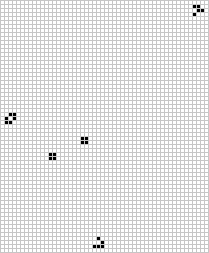Herschel
The Herschel (or, much less commonly, D-heptomino[1][2] or J-heptomino[3]) is a heptomino shaped like the lowercase letter h, which occurs at generation 20 of the B-heptomino. It evolves into two blocks, two gliders and a ship after 128 generations, and also produces a phi spark.
| Herschel | |||
| |||
| View static image | |||
| Pattern type | Methuselah | ||
|---|---|---|---|
| Number of cells | 7 | ||
| Bounding box | 3×4 | ||
| MCPS | 7 | ||
| Lifespan | 128 generations | ||
| Final population | 22 | ||
| L/I | 18.3 | ||
| F/I | 3.1 | ||
| F/L | 0.172 | ||
| L/MCPS | 18.3 | ||
| Discovered by | John Conway | ||
| Year of discovery | 1970 | ||
| |||
| |||
Common uses
Herschels are a recognizable "bottleneck" stage of a very common progression of three small active objects, frequently seen during the evolution of chaotic patterns. An R-pentomino evolves after 28 ticks into a B-heptomino a dozen cells away from the starting point, plus some active trailing junk; the B-heptomino then evolves into a Herschel in another 20 ticks, while traveling another 8 cells in the same direction. 22 ticks and 5 cells later yet the Herschel evolves into a backwards escaping glider (known as the first natural glider, FNG), and a final, unnamed bottleneck pattern that evolves into a larger explosion before settling down.
The unusual distance that R-pentominoes and B-heptominoes travel during their evolution into Herschels has allowed for the development of a growing collection of Herschel conduits, which use catalysts to modify the 128-step reaction. Instead of producing the still lifes and gliders described above, an input Herschel "bounces off" a series of eaters and other catalysts and produces a new output Herschel some distance away. In some cases, the active reaction travels directly "through" one or more transparent catalysts, destroying it completely and re-creating it in the same location several ticks later. The output Herschel can then become the input for another conduit, which may continue in the same direction or turn left or right. If it eventually forms a closed loop, the result is a Herschel-based oscillator or gun.
Most (but not all) conduits only engage the Herschel after its splitting into its final offspring and the FNG. Dealing with the latter is crucial in assembling a track from separate conduits: it is fired in a direction where it would commonly collide with a previous conduit's catalysts. Eater 5 is one of the most convenient solutions for this task.
Etymology
The term "Herschel" is attributed to John Conway, who very early in the history of Life investigated the fates of all polyominoes up to at least 7 bits [4]. The name is commonly ascribed to the Herschel heptomino's similarity to a planetary symbol ♄ erroneously attributed to Uranus (discovered by William Herschel in 1781.) However, in point of fact a Herschel closely resembles the symbol for Saturn, but bears no particular resemblance to either of the symbols used for Uranus. So the appropriate name might actually be "Huygens" -- but "Herschel" is now universally used by tradition.
Image gallery
 Generation 128 of a Herschel |
References
- "D". The Life Lexicon. Stephen Silver. Retrieved on March 25, 2009.
- Robert Wainwright. "Lifeline Volume 1".
- "J-heptomino". The Life Lexicon. Stephen Silver. Retrieved on June 13, 2009.
- Martin Gardner (October, 1970). "Mathematical Games: The fantastic combinations of John Conway's new solitaire game "life"". Retrieved on August 2, 2009.
